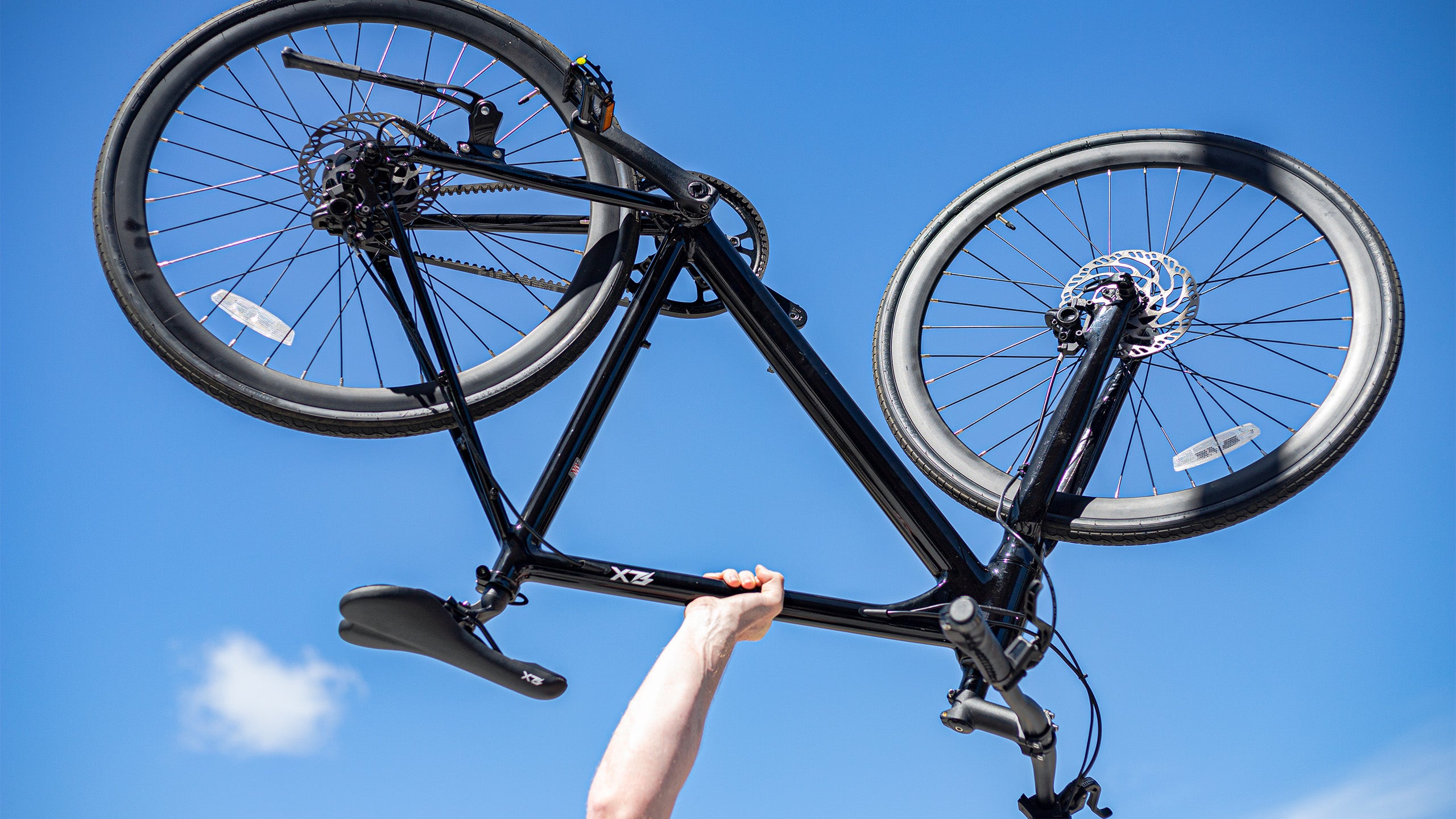Whether you're a casual rider or a hardcore cyclist, you've probably noticed things in the cycling world shifting.
For the better.
- More awareness and acceptance of cyclists on the streets.
- Prominent bike lanes in most cities.
- Electric bikes are taking over the market.
It's not your Dad's cycling world anymore.
So why ride a boring old traditional bicycle?
E-bikes are not only the next big thing; they’re becoming the only choice for some riders.
But with all the new companies popping up and 9 different types of bikes out there, finding the right one for you can be a challenge.
Introducing… The Complete Guide on How to Choose The Right E-Bike Without Breaking the Bank
In this guide; you’ll discover how to choose the right e-bike by learning:
- Why e-bikes make sense.
- What makes an e-bike special.
- A rundown of the different types of e-bikes.
- Which type of e-bike is best for different lifestyles.
- How to choose a brand and model.
- Comparison of popular e-bike brands and types.
- Why Superhuman e-bikes are different.
Use this guide to power your adventures by learning how to choose the right e-bike—without breaking the bank.
First of all, why the heck should you buy an e-bike?
Here’s a hint; it’s not just because they’re green…
E-bikes are on the rise.
Historically, electric bicycles have been a godsend for those with asthma, knee problems, or age-related health issues.
But that doesn’t mean you have to be in less-than-perfect health to take advantage of e-bikes.
More and more people are putting a little power behind their pedals.
Here's why:
More Flexibility
Picture this: You stroll into work after a 20-mile commute on your e-bike, fresh and confident…instead of sweaty and gross.
Or, you’re leading the pack on a virgin trail ride instead of dragging ass at the back.
Efficient. Sleek. And convenient AF.
That’s an e-bike in a nutshell.
Most e-bike owners have their own personal reasons for switching, but…
59%Say it makes a hilly commute easier. |
44%Use it for environmental reasons. |
96%Enjoy the experience. |
Source: TheRoundUp
More Support
Even if you’re a total pro, steep hills and rough trails are a total pain on traditional bikes.
But e-bikes make uphill riding AND carrying heavier loads a breeze.
That 12%-grade hill on your way to work never looked so tempting.
Do more with a little less effort.
The truth is; riding an e-bike is still a great low-impact workout. You just get a little extra support from the engine.
91%Burns almost as many calories as a manual bicycle. Source: EriksBikeShop |
30mSave an average of thirty minutes on your commute or trip. |
60%E-bike riders spend more time riding than traditional cyclists. Source: Canyon |
The best part? You don’t have to wear Spandex to hit the big numbers unless you really want to.
More Economical
The price at the pump is through the roof. Parts and labor are getting harder and harder to find.
It makes sense to ditch the car when you can.
On average, owning a car is 3-4x more expensive than an e-bike. So switching to an e-bike is a total no-brainer.
75%Prefer riding e-bikes to driving their car. |
28%Bought an e-bike to reduce the number of car rides. |
44%Say their e-bike is cheaper than driving. |
Source: TheRoundUp
Whether you’re trying to reduce your carbon footprint, get to work without getting sweaty, or just hit the trails with gusto more often…e-bikes are your ticket.
Now that you know WHY you should pull the trigger on a sexy new e-bike, let’s take a peek at all the different options out there.
How do electric bikes really work?
No, it’s not the same as a motorcycle…
Contrary to popular belief, riding an e-bike is NOT cheating.
Depending on how it’s built, an e-bike is almost as much work as a traditional bicycle.
Motor Types:
Mid-Drive
Located where the pedals meet the frame, a mid-drive applies power to the chain-ring when you pedal. Bikes with a mid-drive motor have a better center of gravity and make it easier to change the rear tire.
Hub-Drive
Integrated directly into the wheel, usually the rear, a hub drive spins the wheel independently. A hub drive system is most common in e-bikes with a throttle. A hub-drive bike is typically more affordable than a mid-drive and puts less strain on the rest of the components.
Propellant Types:
Pedal-Assist
The most common type of e-bike, pedal-assist electric bicycles, are exactly what they sound like. The motor puts a little extra juice behind your pedaling, but it only works if you do.
Throttle
Similar to a dirt bike or motorcycle, throttle-driven e-bikes have a manual hand throttle affixed to the handlebars. It's typically pedal-free, so you can get a boost when you need it.
Most e-bikes, especially higher-end brands, will likely be pedal-assisted models. But, some may also have a throttle. That's where e-bike classes come in.
Classes:
Class 1
Pedal assist only here. These bikes are limited to about 20mph under assistance but will go faster if your legs can.
Class 2
This class of e-bike primarily relies on a throttle and can be combined with pedal assist. But again, they're limited to a top motor-assist speed of 20 mph.
Class 3
These babies offer pedal assistance up to 28 mph and are required to have an onboard speedometer.
Sensors:
Cadence
Cadence sensors detect that you have started spinning the pedals with your feet and tell the motor to engage.
Torque
Torque sensors detect that you are applying pressure to the pedals and tell the motor to engage. This type of sensor is typically more expensive but is preferred because it responds almost instantly with a more ‘natural feeling’ application of power.
Which type of e-bike is right for you?
It's about so much more than just the tires...
Ah, now for the good stuff!
E-bike style and capabilities vary just as much as traditional bikes, and sometimes more.
But all the traditional styles we know, and love are still alive and well within the e-bike world. They just got a little upgrade.
So how can you tell how to choose the right e-bike type for your unique lifestyle?
Here’s a rundown of the basic types of e-bikes and how they compare.
Common types of e-bikes on the market:
Urban Ebikes
Urban ebikes are bikes equipped with an electric motor and battery that provide pedal assisted power to the rider. These Bikes are designed to be used in urban environments, such as city streets, bike paths, and commuter routes. Urban ebikes are usually light weight. The light weight sleek nature of urban ebikes allow for better climbs, faster acceleration, and are nimble enough to zip through city obstacles and pedestrians.
Comfort ebikes
A comfort ebike is a bike that is designed for riders who prioritize comfort and ease of use over speed and performance. Comfort ebikes are built with features that make them more comfortable and convenient to ride, such as a relaxed upright position, a plush saddle, front suspension forks, and usually a step through frame that offers easy mounting and dismounting.
Fat Tire ebikes
Fat Tire ebikes are bikes that have oversized tires designed for riding on soft, loose, or uneven terrain. These bikes typically have tires that are at least 3.8 inches wide. The wide tires provide more surface area and traction, allowing riders to easily navigate through sand, snow, mud, or other challenging terrains. They also provide extra cushioning and shock absorption, making for a smoother and more comfortable ride.
EMTB
Electric mountain bikes, also known as EMTB's, are electric bicycles designed specifically for off-road riding and mountain biking, they are similar in design to traditional mountain bikes but have an electric motor and battery that provides assistance to the rider.
The electric motor on an EMTB in usually located in the bottom brackert, and it provides pedal assist assistance to the rider as they pedal. This extra power makes it easier to climb steep hills and navigate technical terrain, which allows riders to go further and faster than they might on a traditional mountain bike.
Most EMTBs also have a suspension system to absorb. shocks and bumps from rough terrain, as well as wide tires with knobby treads for improved traction on loose or slippery surfaces.
Obviously, each brand’s product will be unique. But this chart is a pretty good glance at the typical averages for each style of e-bike.
Ok, but which e-bike style is right for your lifestyle?
You get it. There are A LOT of e-bike types out there, and they’re all a little different.
So which one is really right for your unique lifestyle?
Here are some general rules:
I’m looking for a comfy daily rider or commuter…
- Urban
- Comfort
I’m looking for a heavy-duty beast of a bike for adventure…
- EMTB
- Fat Tire
I’m looking for a good all-around bike for casual and hardcore play…
- Urban
- Comfort
- Fat Tire
I wanna go fast…
- EMTB
The beauty of a well-designed e-bike? You can usually swap tires on many models and hop from pristine pavement to gravel and back again ez pz. Or you can load up on accessories to give it that extra oomph you’re looking for.
Does e-bike size really matter?
Yes, yes, it does.
If you’ve ever tried to ride a too-tall bike, you know how crazy uncomfortable it is. After just a quick spin around the block, everything hurts.
That’s why finding the correct size e-bike for your height and build is critical.
The main measurements you need to find the right bike size for you are found below.

A: Reach: "Reach" typically refers to a specific measurement that indicates the horizontal distance between the bottom bracket (the center of the pedal crank) and the center of bike's head tube (where the fork is attached). Reach is an essential geometry measurement used to determine a bike's fit and handling characteristics.
B: Stand Over Height: Standover height is another important measurement when it comes to choosing the right bike size and fit. It refers to the vertical distance between the top tube of the bicycle frame and the ground. To measure standover height, you straddle the bike
How to choose an e-bike brand and model?
Focus on what really matters to you…
Choosing the right e-bike for your unique lifestyle can be a total workout…for your brain and your typing fingers. But it’s a big purchase; you don’t want to mess it up.
4 important things to look out for:
Battery Capacity & Charging Time
Batteries have come a long way in recent years, but they still vary from brand to brand. Make sure that the average single-charge ride time and charge time make sense for your lifestyle.
Repairability
Your e-bike will need regular servicing to stay in tip-top shape. Make sure that your brand and model of choice has a solid customer service reputation and limits the use of proprietary parts and technology.
Upgradability
Not all brands make it easy to upgrade their products with aftermarket accessories. And some models are compatible with only one type of tire. If you think your lifestyle needs will change, make sure your e-bike can change with you.
Body Size Support
While most models will have a variety of sizes to accommodate different heights, they don’t always have the same support for higher weight ranges. Pay special attention to the recommended height and weight limits for each model and size.
Popular Traditional Brands:
|
Brand |
Pricepoint |
Style Variety |
|
Gazelle |
$1,499 - $4,999 |
6 models |
|
Trek |
$1,599 - $13,999 |
13 models |
|
Cannondale |
$1,675 - $8,650 |
13 models |
|
Canyon |
$1,999 - $8,199 |
4 models |
|
Giant |
$2,750 - $15,000 |
7 models |
Popular DTC E-bike brands:
|
Brand |
Pricepoint |
Style Variety |
|
Lectric eBikes |
$799 - $1,599 |
6 models |
|
Electric Bike Company |
$1,199 - $2,499 |
7 models |
|
Juiced |
$1,299 - 3,499 |
5 models |
|
Rad Power Bikes |
$1,499 - $2,499 |
5 models |
|
Superhuman |
$1,499 - $9,999 |
7 models |
How do Superhuman e-bikes compare to the rest of the market?
We’re a little biased, but…
As of late 2022, there were already over 200 e-bike brands in the U.S. market—not counting the big dogs.
Being overwhelmed is pretty normal.
That’s why we made this guide…to help make your decision a wee bit easier. If that’s even possible.
So when it comes down to the real question at hand: “What e-bike is right for me?”
Here’s why Superhuman should be at the top of your list:
Assembled in Detroit
Most electric bike components are made overseas, just like everything else. The difference is where they’re assembled.
At Superhuman, all of our bikes are assembled in Detroit, Michigan.
This means that we can maintain a tight grip on quality control, reduce shipping times and costs, and create meaningful jobs in Motor City. Kinda poetic if you think about it.
Extensive Testing
UN3481
Sleek Designs
While many popular e-bike companies are still stuck in the space age with clunky designs and huge battery enclosures, Superhuman makes design a priority. Second only to performance.
We design from the ground up with clean lines, simple controls, efficient motors, high-capacity batteries, and add-ons that turn heads.
At first glance, you’d never even know that an Superhuman model is electric. And you’re guaranteed to get compliments and head turns wherever you ride.
Find the right Superhuman e-bike for your lifestyle…
With seven unique models in four separate categories, Superhuman e-bikes offer a level of flexibility that many other brands can’t promise.
Whether you’re looking for a chill cruiser for weekend fun, a hardcore rider hitting the trails, or a dependable daily rider for commuting to and from work…you’re in the right place.

Choosing the right e-bike for your lifestyle doesn’t have to be a pain OR cost a fortune…
E-bikes are HOT, and if you pass up the chance to get one because it’s confusing, you’re crazy. That’s why we hope this guide will help you make the right choice and make it without breaking the bank or your sanity.
The biggest piece of advice we can offer is to take your time and weigh your options just like you would with any big purchase decision. Ask questions. Test drive different brands and models, if possible. Many brands offer test drives and even rent e-bikes for the day.
And when you’ve finally made your decision, we promise you’ll love nothing more than taking your new toy for a ride every single day.





Share:
How To: Assemble a F5 Trail Touring
San Diego River Parkway E-bike Ride